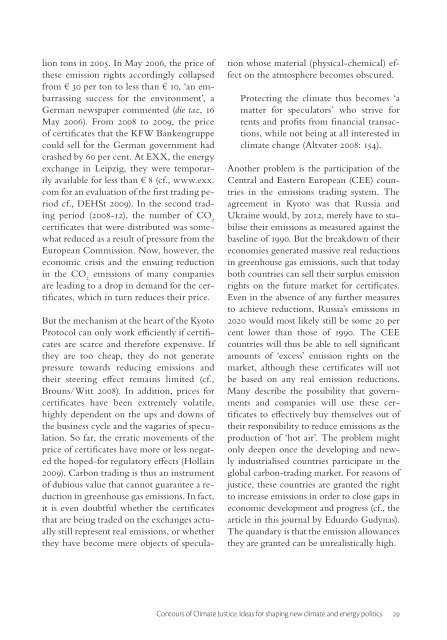Contours of Climate Justice - Dag Hammarskjöld Foundation
Contours of Climate Justice - Dag Hammarskjöld Foundation
Contours of Climate Justice - Dag Hammarskjöld Foundation
You also want an ePaper? Increase the reach of your titles
YUMPU automatically turns print PDFs into web optimized ePapers that Google loves.
lion tons in 2005. In May 2006, the price <strong>of</strong><br />
these emission rights accordingly collapsed<br />
from € 30 per ton to less than € 10, ‘an embarrassing<br />
success for the environment’, a<br />
German newspaper commented (die taz, 16<br />
May 2006). From 2008 to 2009, the price<br />
<strong>of</strong> certifi cates that the KFW Bankengruppe<br />
could sell for the German government had<br />
crashed by 60 per cent. At EXX, the energy<br />
exchange in Leipzig, they were temporarily<br />
available for less than € 8 (cf., www.exx.<br />
com for an evaluation <strong>of</strong> the fi rst trading period<br />
cf., DEHSt 2009). In the second trading<br />
period (2008-12), the number <strong>of</strong> CO 2<br />
certifi cates that were distributed was somewhat<br />
reduced as a result <strong>of</strong> pressure from the<br />
European Commission. Now, however, the<br />
economic crisis and the ensuing reduction<br />
in the CO 2 emissions <strong>of</strong> many companies<br />
are leading to a drop in demand for the certifi<br />
cates, which in turn reduces their price.<br />
But the mechanism at the heart <strong>of</strong> the Kyoto<br />
Protocol can only work effi ciently if certifi -<br />
cates are scarce and therefore expensive. If<br />
they are too cheap, they do not generate<br />
pressure towards reducing emissions and<br />
their steering eff ect remains limited (cf.,<br />
Brouns/Witt 2008). In addition, prices for<br />
certifi cates have been extremely volatile,<br />
highly dependent on the ups and downs <strong>of</strong><br />
the business cycle and the vagaries <strong>of</strong> speculation.<br />
So far, the erratic movements <strong>of</strong> the<br />
price <strong>of</strong> certifi cates have more or less negated<br />
the hoped-for regulatory eff ects (Hollain<br />
2009). Carbon trading is thus an instrument<br />
<strong>of</strong> dubious value that cannot guarantee a reduction<br />
in greenhouse gas emissions. In fact,<br />
it is even doubtful whether the certifi cates<br />
that are being traded on the exchanges actually<br />
still represent real emissions, or whether<br />
they have become mere objects <strong>of</strong> specula-<br />
tion whose material (physical-chemical) effect<br />
on the atmosphere becomes obscured.<br />
Protecting the climate thus becomes ‘a<br />
matter for speculators’ who strive for<br />
rents and pr<strong>of</strong>i ts from fi nancial transactions,<br />
while not being at all interested in<br />
climate change (Altvater 2008: 154).<br />
Another problem is the participation <strong>of</strong> the<br />
Central and Eastern European (CEE) countries<br />
in the emissions trading system. The<br />
agreement in Kyoto was that Russia and<br />
Ukraine would, by 2012, merely have to stabilise<br />
their emissions as measured against the<br />
baseline <strong>of</strong> 1990. But the breakdown <strong>of</strong> their<br />
economies generated massive real reductions<br />
in greenhouse gas emissions, such that today<br />
both countries can sell their surplus emission<br />
rights on the future market for certifi cates.<br />
Even in the absence <strong>of</strong> any further measures<br />
to achieve reductions, Russia’s emissions in<br />
2020 would most likely still be some 20 per<br />
cent lower than those <strong>of</strong> 1990. The CEE<br />
countries will thus be able to sell signifi cant<br />
amounts <strong>of</strong> ‘excess’ emission rights on the<br />
market, although these certifi cates will not<br />
be based on any real emission reductions.<br />
Many describe the possibility that governments<br />
and companies will use these certifi<br />
cates to eff ectively buy themselves out <strong>of</strong><br />
their responsibility to reduce emissions as the<br />
production <strong>of</strong> ‘hot air’. The problem might<br />
only deepen once the developing and newly<br />
industrialised countries participate in the<br />
global carbon-trading market. For reasons <strong>of</strong><br />
justice, these countries are granted the right<br />
to increase emissions in order to close gaps in<br />
economic development and progress (cf., the<br />
article in this journal by Eduardo Gudynas).<br />
The quandary is that the emission allowances<br />
they are granted can be unrealistically high.<br />
<strong>Contours</strong> <strong>of</strong> <strong>Climate</strong> <strong>Justice</strong>. Ideas for shaping new climate and energy politics 29
















